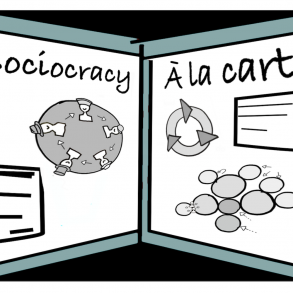By Ruben Timmerman, originally published by Medium.com
This is a copy of our internal Rules of Engagement, updated when our Communication Clarity roles updates them internally in our helpdesk system. You can read more about communication, rules, policies and processes in this article.
PS: as a customer, partner, employee, parent, husband, friend, pet or child of a Springeteer, you can not derive rights from these rules 😉
With all our communication channels exploding, and more tools replacing even more tools, I thought it might be good to share what we expect of everyone, communication-tool-wise 🙂
The rules of the tools
1. Sputr: Scan (and read what’s interesting ;)) all posts (not replies per se), within 2 business days.
2. Asana: Read and respond to all inbox items, within 2 business days.
3. Slack: Respond to direct messages and mentions of your (user)name within a few hours, @here / @channel you should also read in your role’s channels.
Don’t ask someone if you can ask them a question and don’t spend extra lines saying “Hello” (goes for Asana too): just say it, preferably in 1 go, not in several messages! And say what you link to, not just <link> “what do you think?”.This way, somebody can actually act right away instead of waiting for your actual need.
It’s not needed to follow all Slack channels, especially not the team-specific ones, and only use the #general channel if you’re sure it interests everyone (and use #random for fun stuff). Only use @here or @channel when it’s really needed that everyone sees your post.
4. E-mail: Never e-mail another Springeteer, unless you’re communicating with the outside world.
Respond to mail within 2 business days. Preferably, respond within 2 hours with an estimate of when you can actually process the mail, so the customer feels heard quickly.
5. Real life: Respond to face to face (or phone) requests immediately, but be modest in using them and ask via Slack first if person can be interrupted if (s)he) wears headphones or seems focussed 🙂
6. Slack or Asana?
If you are in hurry (quicker than 2 days) or you just need a clarification: Slack. If it’s not urgent or big, make an Asana, but if it’s urgent and big > Asana so it’s more structured and easier to find back for others.
– If a customer is waiting, Asana is too slow, as every response can take 2 days (ping pong).
– For next actions: always prefer Asana and if you are in a hurry, copy paste the URL it to Slack incl. a few words of what you need so someone knows before they click.
When you complete a task or say something like “I’ve made this into a project / task”, always leave a paper trail of what you did and where to find it.
7. Appreciating = Communicating. Let people know you have read their Sputr-posts by ? liking it or commenting to it, same for ❤ in Asana and reactions in Slack 🙂
8. Remote working: be prepared to be a bit more responsive to requests on Slack, because people can’t reach you in real life. And keep your phone close 🙂
But but it’s too much!!! Nah… We can always revisit these rules, and should discuss these things in our FTHM. It’s essential to keep your communication channels clean so we can depend on each other. It’s not acceptable to say “if I don’t respond you should just ask me on another channel”, because that creates the expectation that we could just drop our inbox and wait for something to catch fire before we respond.
Communication with the outside world
Be sure to also check out our Communication tone of voice and style guide.
We want to be fast for great customer happiness. Because of our different target groups, we have support requests coming in from many sides (mediapartners, providers, users, suppliers, Go clients) and very often they mix, because it’s our role to connect those groups… So, to make sure we still delight them with our snappy and friendly response, some pointers:

1. Our first response: should be within 2 working hours.
2. Our resolution time: within 24 working hours. This is very hard if an external party is involved, but in those cases you can call Pending resolved too: as soon as the request has been processed and sent to an external party, and the support requester has been notified within 24 hours, we’re cool/.
3. You touch it, you own it: if you are working in a mailbox and are not accountable for solving the user’s problem, you are responsible for making sure someone else takes care of first response within 2 hours. So you’ll probably have to ask someone in Slack to take on the ticket.
4. You move it, you (un)assign it: if you have to move the ticket to another mailbox, or if you have to make a new ticket cuz it’s an incoming call or chat, you make sure you unassign yourself from it and either assign someone you pinged, or unassign so it’s visible in Unassigned in the other mailbox. Also make sure the ticket is Active when you assign it to someone else or move it to anther mailbox.
5. You touch it, you don’t disappoint the user: if you suspect we cannot achieve 1. and / or 2., you have to tell the user that a delay is to be expected. In case the person who is accountable isn’t there, can’t fix it soon, or of course in case an external party is involved in which case 2. is happening still.
And, depending on your roles there might be other Rules of Engagement applicable:
- Rules of Engagement: Inbox
- Rules of Engagement: Inbound
- Rules of Engagement: Booking Requests
- Rules of Engagement: Learning Advice
So are we not human anymore?
We are still be human, and if you’re really busy (behind on communication) for a few days, just share that with whoever depends on you so they know. It’s perfectly acceptable to respond to an incoming task or question with “No time for this in the coming days, let me know if there’s tension with that!”.
Also: if you’re really busy I think you can still scan your inbox at the beginning of your day for 10 minutes to make sure there’s no 5 second answers you can give to help your colleague progress her task. You can just skip the rest and mark the as upcoming actions, this is basic GTD: separating processing from doing. And just ask one of our David Allen roles if you need a helping hand with GTD 🙂
Featured Image/graphic link by Enlivening Edge.
Republished with permission of the author.




